More to the Death
Last week, I began telling card-by-card design stories from Theros Beyond Death. I have more stories to tell though.
Haktos the Unscarred

In Theros, Ethan Fleischer designed a card for Achilles, the Greek hero that had been dipped into the River Styx by his mother and was invulnerable everywhere but the heel of the foot she held him by to dip him in. (It's where the term Achille's heel comes from.) He was a great warrior but was ultimately defeated when he was shot with an arrow in his heel. Ethan's design was clever. Achilles had protection from everything except spells with the converted mana cost of 3. We handed it over from design, but for some reason, it never made it to print. Upon our return, Ethan had learned from me that sometimes the way to get cards made is to just keep submitting them. He put it in the file again, tweaked slightly, and this time it made it to print.
Heliod's Intervention, Thassa's Intervention, Erebos's Intervention, Purphoros's Intervention, and Nylea's Intervention
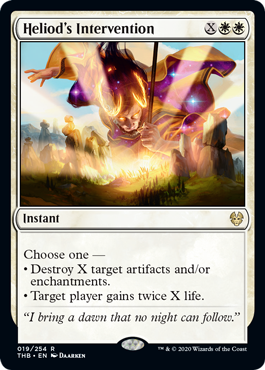

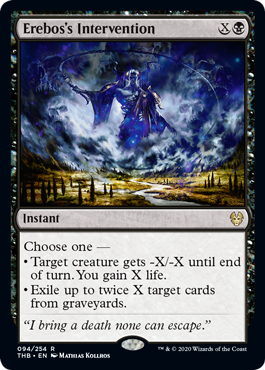
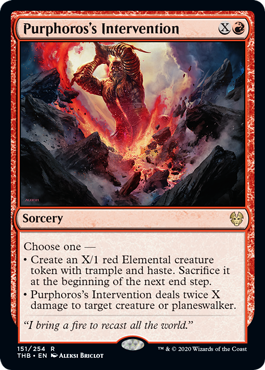
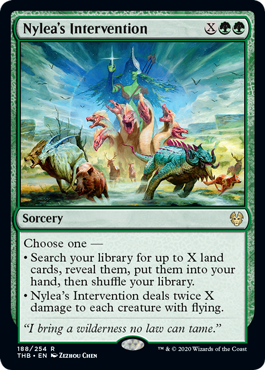
The five major Therosian Gods are a cycle of mythic rare creatures. The Design team wanted to reference the Gods again but at a lower rarity. What was something they could do that was splashy but felt more at home at say, rare? After examining different options, they decided to make it a spell cycle. To make it splashy, they decided to make it an X cycle. X cycles historically are very popular with the players because they have a large potential. When players look at new cards, they like to imagine what's the best thing the spell could possibly do, and X spells have a huge upside.
We've done a lot of X spells over the years though. What could make this cycle stand out? How about a modal X spell? That isn't something we've done much of. It sounded cool. Now came the hard part—building the cycle. The way this is done when you have a cycle is to design all five cards at once to make sure that you're not overlapping abilities. Also, it was decided that each card could cost X plus any amount of colored mana, but that meant the two effects had to work for the same cost.
The first thing we did was write every X spell effect we could think of on a white board: (Remember that the effects can't be too long as we have to fit the text of both abilities on the card.)
- Direct damage
- Life gain
- -X/-X to a creature until end of turn
- +X/+X to a creature until end of turn
- Mill
- Discard cards
- Unsummon creatures
- +1/+1 counters
- Token creation
- Can't block
- Change into X/X creature
- Draw cards
- Impulse (Look at Top X cards of library and take one)
- Freeze (Tap, and they don't untap next turn)
- Destroy X artifacts
- Destroy X creatures
- Destroy X enchantments
- Destroy X lands
- Search deck for card of converted mana cost X or less
- Reanimate creature of converted mana cost X or less
- Gain control of creature of converted mana cost X or less
- Counter spell unless X is paid
- Drain X from a creature (or a player)
- X creatures are unblockable
- Fetch X lands from the library and put them onto the battlefield
This isn't a complete list but represents a first pass at finding X effects.
Many of these effects won't work for numerous reasons. One, they might be too weak, especially for a splashy rare. Two, they might be problematic from a play design perspective. Three, they might not be able to be costed using a single X (some of our bigger X effects use XX in the cost).
The Design team then took each effect and put it into one of three boxes:
Yes – this is a great effect to use.
No – this isn't an effect we want.
Maybe – this effect isn't good enough as is, but we could tweak it.
One of the biggest reasons effects ended up in the maybe box was a power level concern. Some effects just weren't powerful enough to compete with other effects. Remember, the Design team wanted both effects to be something that a player might choose. To solve this, they came up with the idea of occasionally using "twice X" so that they could make certain weaker effects have more oomph.
The team then identified what color each ability could be in. For example, "Gain twice X life" could be green or could be white. Having it work in two different colors gave them flexibility because it allowed them to shift around what color used what abilities. Some abilities only went into one color, so those got placed first.
Both impulse for X (getting two cards—that was the tweak) and counter target spell unless the opponent pays X were blue effects, so those went to blue. Likewise, -X/-X to a creature was solely in black. Direct damage was solely red. Land search was solely green. Life gain, destroy artifacts and enchantments, and exiling cards in graveyards could all be white, but none was exclusively white. Making creature tokens could go in any color but would vary in what kind of tokens were made. The Design team preferred temporary tokens (ones with haste that got sacrificed at end of turn), and that felt way more red than any other color. It was decided to give the life gain and artifact/enchantment destruction to white and the graveyard exiling to black (partly because it was one of the more conditional effects, but black's other effect was a kill spell which is most often useful). That left one slot for green. The Design team ended up with a direct-damage effect to fliers—not something green does a lot, but in its pie.
Then, to balance the effects, three of them were made to have two colored mana in their cost (green, white, and blue) and two of them were made sorceries rather than instants (red and green). Note that while I presented this as if it was done in one sitting, it actually was a constant evolution over many months involving a lot of feedback from playtests and play design.
Hero of the Games, Hero of the Nyxborn, Hero of the Pride, Heroes of the Revel, and Hero of the Winds

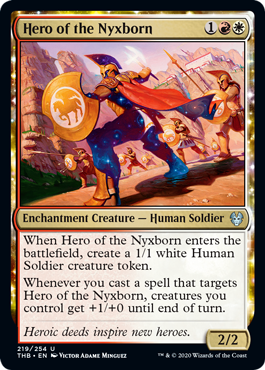

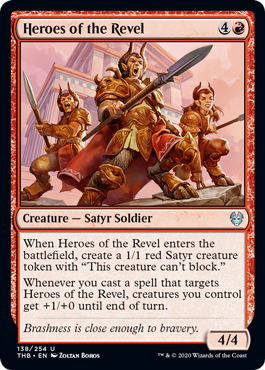
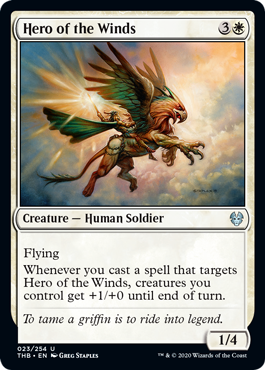
During my preview columns, I talked about how we examined all the mechanics in Theros block to see which ones we wanted to bring back. Devotion and constellation made the cut, but there were numerous other ones we thought about. One of those was heroic. Heroic was a mechanic where you got an effect if the creature with the heroic ability was targeted. As a nod to heroic, the Design team made a series of five cards, all in red and white, to essentially have the heroic ability, just non-keyworded. To keep it simple, all five cards have the same effect, granting +1/+0 to all your creatures. That ability was chosen because it played into the go-wide aggressive nature of the red-white archetype. The effect was initially +1/+1, but the ability to change toughness at instant speed in the middle of combat ended up making the ability too strong, so it was changed to +1/+0.
Kroxa, Titan of Death's Hunger and Uro, Titan of Nature's Wrath
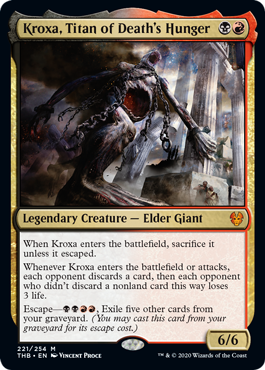
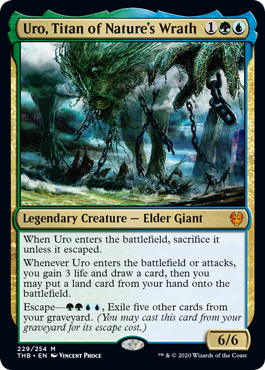
Part of visiting the Underworld was our ability to bring up stories of the past. One of those stories was about the Elder Giants. I think in the beginning our plan was to have five Elder Giants, but they really felt like mythic rare creatures and we didn't end up having enough slots for all five, so we settled on the two we liked the most. As the creatures were modelled after the titans from Greek Mythology, we felt it would be fun to model them after the titans from Magic 2011 (which I believe were modeled after the titans from Greek mythology).
They're 6/6 Giants that have a powerful effect when they enter the battlefield or attack, but with one cool new twist. They're immediately sacrificed if they're not cast from the graveyard. This means that when you first cast them, they trigger their "enters the battlefield" effect and then instantly die. Then once you can get them out of the graveyard, they can start attacking and doing real damage. Perhaps if they're popular, we can meet more on a future return to Theros.
Labyrinth of Skophos and Skophos Maze-Warden

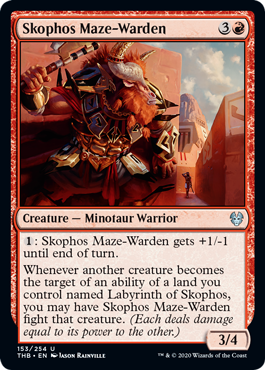
In Theros block, we tried to do as many top-down designs based on Greek mythology as we could. While we hit a lot of them, we didn't hit them all. One of the most famous stories was that of Theseus. He had to face the Minotaur (in Greek mythology there was just one Minotaur) in a maze. The card Labyrinth Champion hinted at Theseus, but we didn't really touch upon the maze or the Minotaur (although Theros block did have a lot of Minotaurs). This visit to Theros, we decided to correct that.
The Labyrinth of Skophos was designed first. Being a maze, it was modeled after the most famous maze card in Magic:
Maze of Ith from The Dark was a very powerful card and saw a lot of play. The Labyrinth of Skophos had a similar flavor where you're removing creatures from combat because they're getting "lost" in the maze. While Maze of Ith just prevented the damage to and from the creature, Labyrinth of Skophos instead removes the creature from combat. The Labyrinth can also affect blockers where Maze of Ith was only usable on attacking creatures.
The Design team spent a lot of time trying to figure out how the maze would lead you to fight the Minotaur, but they finally figured it out. The Minotaur was designed to be a creature that was good at fighting. It was a base 3/4 but could activate to shift his toughness into his power. If you use the Labyrinth on a creature, the Skophos Maze-Warden can then fight anything "lost" inside the maze.
Nyxborn Courser, Nyxborn Seaguard, Nyxborn Marauder, Nyxborn Brute, and Nyxborn Colossus
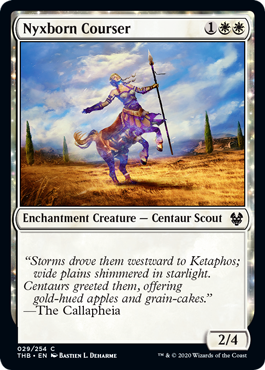
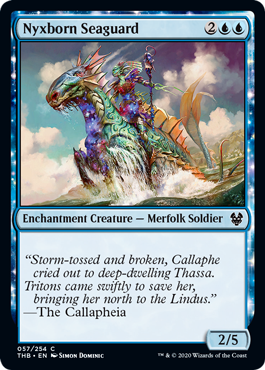


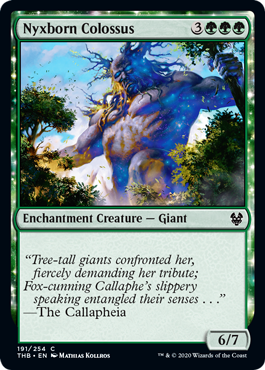
One of the issues you have to deal with when designing a set is something we refer to as cognitive load. Basically, it means how much thinking has to go on for a player to absorb all the things they have to care about in the game. If the cognitive load is too low, the game can get a little boring. If the cognitive load is too high, it can become overwhelming, making it hard for players to concentrate. The trick is trying to find the right balance.
If your set has too low a cognitive load, you simply have to add in a few more cards that make the player have to consider other aspects while playing. This is usually not the problem though. I can count on a single hand the number of times a note from a playtest was "not enough cognitive load." Most often, the issue is you have too much going on and the cognitive load is too high.
For Limited, which is where we care the most about this (in Constructed, a player has the ability to set the cognitive load—at least for their deck—at whatever level is comfortable for them), cognitive load is mostly an issue with the common cards. They make up over two-thirds of the environment, and if your goal is to raise or lower cognitive load, it's mostly about setting the commons at the right place.
The trick to lowering cognitive load is to increase the number of simple cards at common. The simplest is either a basic spell that has little interaction ("Gain 3 life" as an example) or a vanilla creature (aka a creature with zero rules text). The challenge with vanilla creatures is finding a way to make them fit the set thematically. Usually, most of that work is put onto the Creative team as the flavor is what makes the vanilla creature feel at home, but the Design teams are always looking for ways to make the vanilla creatures matter mechanically. The most common way to do this is with the creature type. If the set has a tribal theme, making your vanilla creatures of that tribe makes them mechanically relevant.
The interesting thing about the vanilla creatures from Theros Beyond Death is that we were able to find not one but two different ways to make them mechanically relevant without having to rely on creature type. First, we made all of them enchantment creatures. The set has an "enchantments matter" theme, including the keyword mechanic constellation, which makes their enchantment-ness very important. Second, all five of the cycle (note that we've been moving away from always having a cycle of vanilla creatures, but they fit so well here, we felt it was okay) have two colored mana in their mana cost. This was done so they would also play well with devotion. As both enchantments and devotion are tied thematically to the Gods, it made creative sense to overlap the two qualities.
Omen of the Sun, Omen of the Sea, Omen of the Dead, Omen of the Forge, and Omen of the Hunt
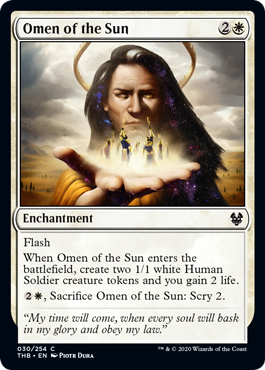

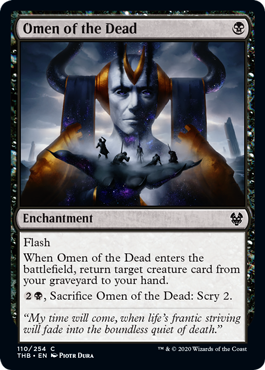
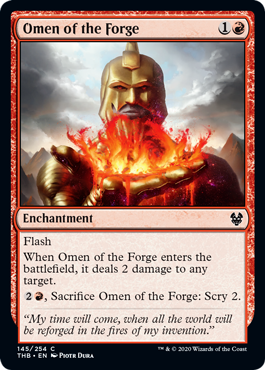
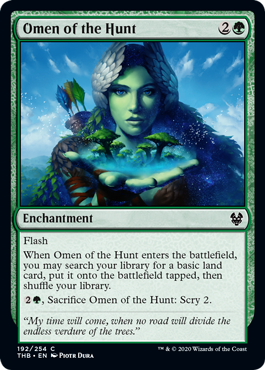
Whenever you see a common cycle, that's usually a sign that it's structurally an important part of the set. I want to examine how exactly the omens work while walking through what role the cycle is mechanically playing. The easiest way to do this is by examining what the five cards have in common:
Enchantments – All the omens are global enchantments. The set has a "enchantments matter" theme, so it's good to get extra enchantments into the set.
Low mana cost – All the omens cost three or less. This was done to make them easier to play at more times. Maybe you want to play them early to help ramp up your devotion, or maybe you save them for later when casting them might be more opportune for a constellation trigger.
Flash – All the omens can be cast whenever you can cast an instant. This is important because of constellation. We wanted to make sure that you could trigger it not just on your turn during one of your main phases, when you would normally play enchantments, but occasionally at other times—during combat or on your opponent's turn, for instance.
"Enters the battlefield" effects – All the omens do something when you cast them. This is important a) to make sure you get enough value out of them and b) to allow us to replace slots that would normally be for instants with enchantments to up the as-fan of enchantments in the set.
Sacrifice ability – All the omens can be sacrificed for a second effect. This was done primarily to make them feel like enchantments. Enchantments that just enter the battlefield and then do nothing on all future turns feel odd. It also allows the enchantments to have extra utility to again encourage people to play them.
They show off one of the main Gods – Theros has a pantheon of five major Gods (and ten more minor ones). The Gods themselves are mythic rares and aren't cards players will see very often, especially in Limited. The common cycle of omens just helps get their faces in front of more players to help remind them of who the major Gods are (note that this is also helped by other cards referencing the Gods in their card name).
As you can see, this cycle of five cards is carrying a lot of structural weight for the set.
Pharika's Libation
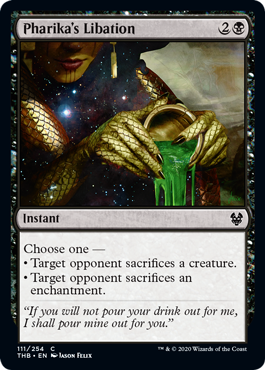
One day, Erik Lauer came to talk with me. He was concerned about the color black. Other than blue, which doesn't tend to destroy things, every color had one card type it couldn't destroy. White couldn't destroy lands (well, singular lands), red couldn't destroy enchantments, and green couldn't destroy creatures, but black had two things it couldn't destroy, artifacts and enchantments. Also, red, green, and white can all destroy artifacts, but only green and white could destroy enchantments. His suggestion to fix this issue—what if we let black start destroying enchantments?
I took the idea to the Council of Colors. They were sympathetic with what Erik was saying. It was odd that it was harder to kill enchantments than artifacts, and the fact that three colors could destroy artifacts but only two could destroy enchantments was odd. Letting black have access to enchantment destruction would fix some of these issues, but there was a problem. The reason we haven't let black have enchantment destruction was partly because we liked the "deal with the devil" enchantments we make in black and didn't want black to be able to easily get rid of them.
What if, someone suggested, we don't let black get rid of its own enchantments but only their opponent's enchantments? We also decided that if we introduced it, we wanted it to be the weakest color at enchantment destruction. This led to the suggestion of allowing black to make the opponent sacrifice enchantments. Okay, let's give it a try. Our first attempt was a card called Mire in Misery in Commander (2019 Edition).
It definitely raised a few eyebrows as this was us letting black explore new color pie space, but overall, the effect was pretty weak. (Note that we tend to shoot a little low when exploring new color pie space as we're trying to get a sense of what works.) Theros Beyond Death is our next foray into this new area for black. Pharika's Libation still forces the opponent to sacrifice a creature or enchantment but now makes it modal so you could choose which card type you want to affect. This will make it a little easier to get rid of a pesky enchantment, although probably not too easy in an enchantment-rich deck (or Theros Beyond Death Limited).
Death Takes a Holiday
That's all the stories I have for this week. If you have any feedback on any of the cards, this column, or Theros Beyond Death, please feel free to email me or contact me through any of my social media accounts (Twitter, Tumblr, and Instagram).
Join me next week when I answer your questions about Theros Beyond Death.
Until then, may you too escape death many times.
#705: Tempest Cards, Part 2
#705: Tempest Cards, Part 2
37:01
This is part two of a four-part series of card-by-card design stories from Tempest.
#706: Blue-Black
#706: Blue-Black
38:10
This is the second, of ten, in my two-color philosophy series.
- Episode 704 Tempest Cards, Part 1
- Episode 703 Trivia – Top 50 Creature Types
- Episode 702 White-Blue

